Note, this is the second half of my loop through Sudan with Dragoman Tours. In case you missed the first half, you can find it here.
At this point of the tour, Day Five, we had now arrived at the main tourist attraction of Sudan, and the main reason the majority of travelers take this tour…the Meroë Pyramids, reportedly the finest example of Nubian pyramids in existence.
As I mentioned in a previous post, Sudan claims “more pyramids than Egypt!” While this is true with Egypt claiming 120, and Sudan having around 200, the Nubian pyramids are significantly smaller. They have a smaller base, rarely wider than 25 ft with steep sides, and range in height from 20 to 100 ft. Often times a “pylon” or even two will mark the entrance.
Meroë was the south capital of the Kingdom of Kush that spanned the period from 800 BC to 350 AD. The area consists of the royal city of the Kushite kings at Meroë near the Nile River, the nearby religious sites of Naqa and Musawwarat es Sufra, which we would visit later that afternoon.. During the Meroitic period, over forty queens and kings were buried here.
These pyramids were partially demolished by Italian treasure hunter Giuseppe Ferlini in the 1830’s, who decapitated them looking for burial treasure. He is believed to have destroyed over 40 pyramids. He sold his loot in Germany, much which can now be seen in the State Museum of Egyptian Art of Munich, and the Egyptian Museum of Berlin.
We would bush camp just on the other side of the sand dunes from the pyramids. As soon as the Big Orange Truck stopped rolling, over the dunes the camels came galloping, their herders offering to give us rides. There were no takers, however as the sun was dropping fast, and tents still had to be pitched and dinner prepared. And it was my turn to cook!
Prior to leaving Khartoum, our leader Louise held a pre-trip briefing whereby the “rules of the road” were explained, along with an orientation of the truck, “Amelia.” The storage areas beneath the coach held a full kitchen, along with every utensil, spice, and staple one could need for three bountiful meals a day to feed 25 people. We were divided into five cook groups of four, each with the responsibility of planning, shopping, and preparing one breakfast, lunch, and dinner meal per group. Now I have lived alone for almost 30 years, and while I have done a good bit of entertaining in my past life, it’s never been for more than a group of eight or ten.. I can’t begin to tell you how intimidating it is to have to prepare a meal for 25 people!! And in the desert, no less!
Considering that all meals had to be sourced from local markets whereby each group would prepare a menu and make a shopping list, only to get to the market and find half the ingredients were a pipe dream, we did okay. Our breakfast was French Toast with quartered oranges. For lunch, we bought 100 falafels and hot pita bread “to go” from a stand within the market. So all that was needed was some tahini sauce made from scratch, and a cucumber and tomato salad.
The more challenging meal however was dinner. While most groups strived to keep it to “one pot meals,” our cook group leader was hell-bent on cooking BBQ chicken on the grill. However, there was concern that we could not get the grill hot enough to cook the large chicken quarters thoroughly, so we had to pan-fry the chicken first before placing it on the grill. One hundred pieces of chicken, each individually seasoned, pan-fried and grilled. We had two large skillets and a wok going simultaneously. Figures the one who hates to cook and hates to clean up even more would end up on the team that dirtied every pot and pan in the bin!
The next morning, we had a 5:30am wake-up call for our 15 minute walk from our bush camp to the site. We would first climb a small hill overlooking the pyramid site and watch the sun rise as our local guide Nazar explained the history of the area. After that, we were free to roam on our own.
Being at the Meroë pyramid site at sunrise was magical. The windswept dunes exuded warmth as the sun cast its early morning hues, turning the sand from deep cool russet, warming it up to a firey copper, then a sun-bleached apricot glow that seemed to reflect back on my face, penetrating my skin, warming my psyche. Walking among these ancient symbols to honor kings and queens without guards, guides, fences, or tour bus parking lots was a memory I hope I can hold on to for a lifetime. Free to wander among the dunes, open the door to the antechamber and enter into the tomb, have the chamber all to myself as I study the interior carvings and hieroglyphics, scanning the thousand year old images with my eyes and fingertips, wondering what the ancients were trying to tell us…and wondering what they would think if they knew the “farangi” (white woman) had traveled halfway around the globe just to admire their handiwork.

This group of camel herders came running as soon as the truck stopped at our night camp spot, offering camel rides.
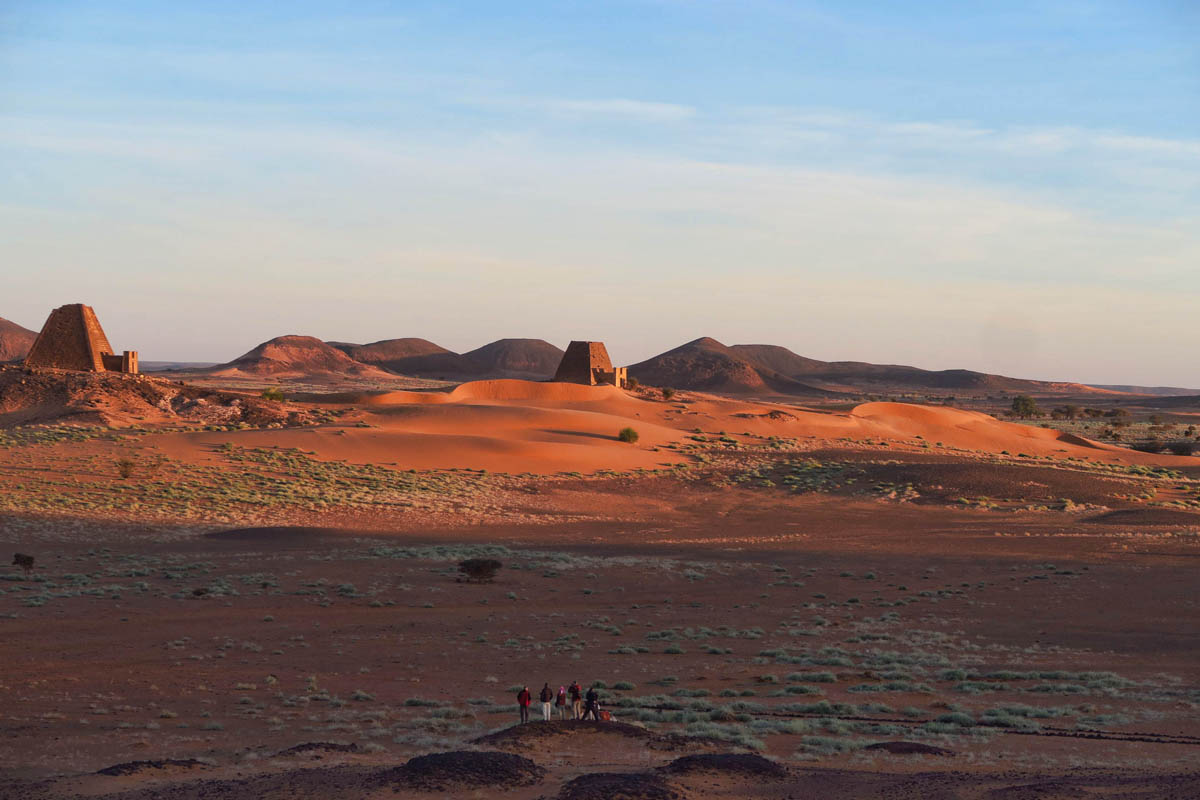
Watching from the hillside above while the group at the bottom of the photo is watching on a mound below as the sun lights up the Meroë pyramids, Sudan’s most famous tourist site.

It’s like watching a light show focused on an art sculpture exhibit.

Lone camel rider in the center of photo gives some scale to the vastness and emptiness of the site.

The Meroë pyramids all have “pylons” in front, the definition in this case being “the gateway to the inner part of an Ancient Egyptian temple.”

Many of the doorways are unlocked, making it possible to enter and have a look around, viewing the hieroglyphics and carvings inside.

A couple of the larger pyramids had double pylons, or two entrance-ways separated by a small courtyard.

The Meroë pyramid site, a UNESCO World Heritage site since 2011. Note a lot of the pyramids were decapitated by an Italian looter.
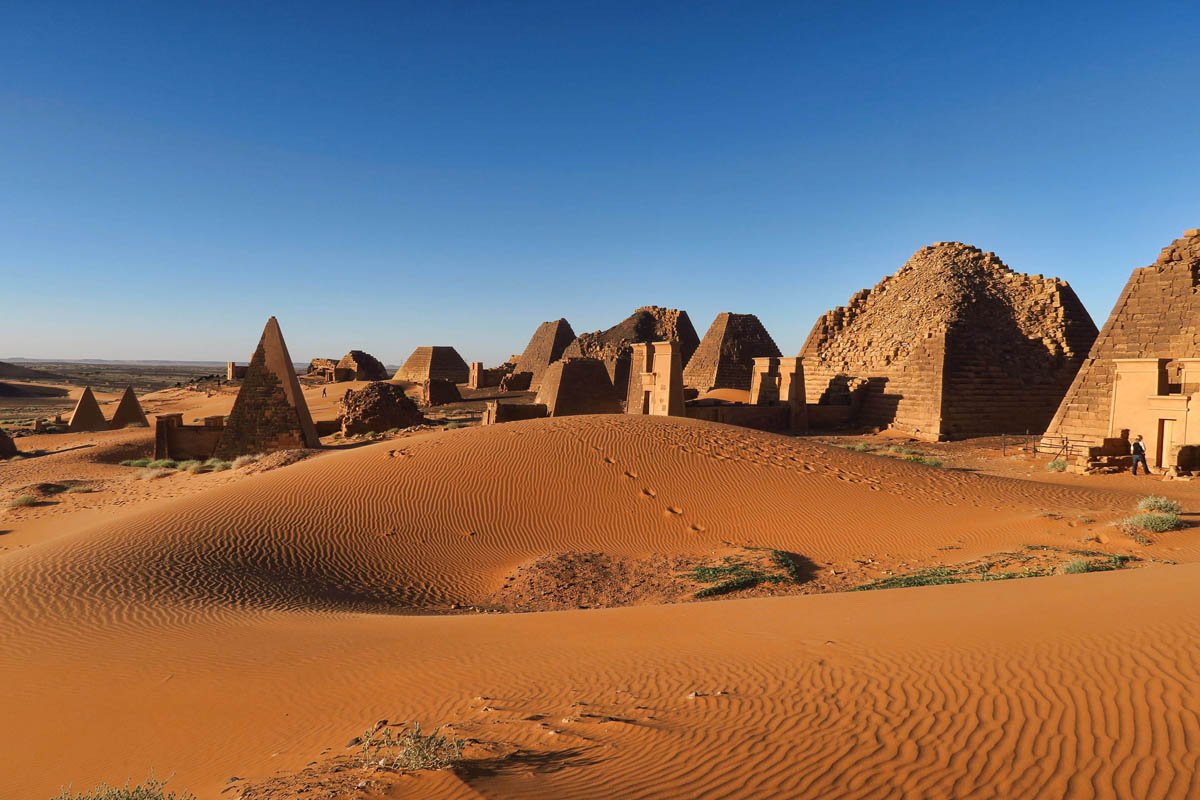
The beautifully sculpted dunes were so intriguing.
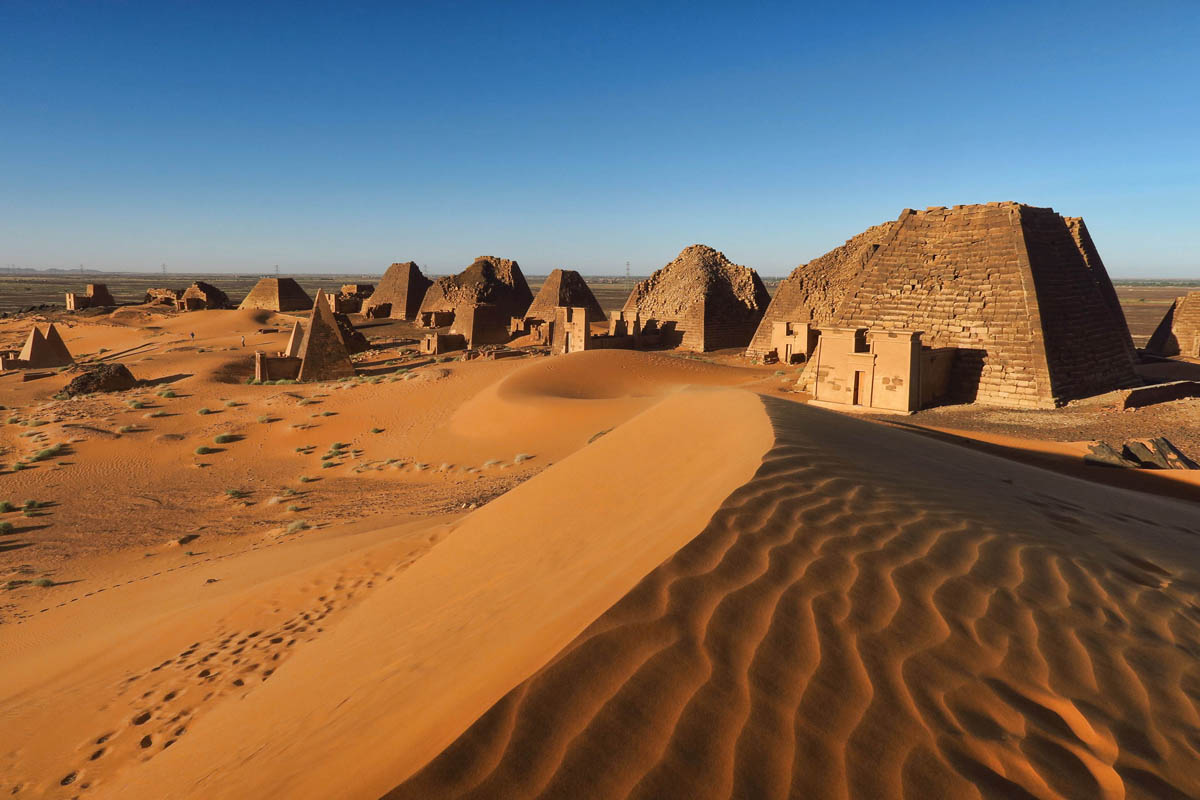
It takes continual maintenance to remove the sand to prevent the pyramids from being buried.
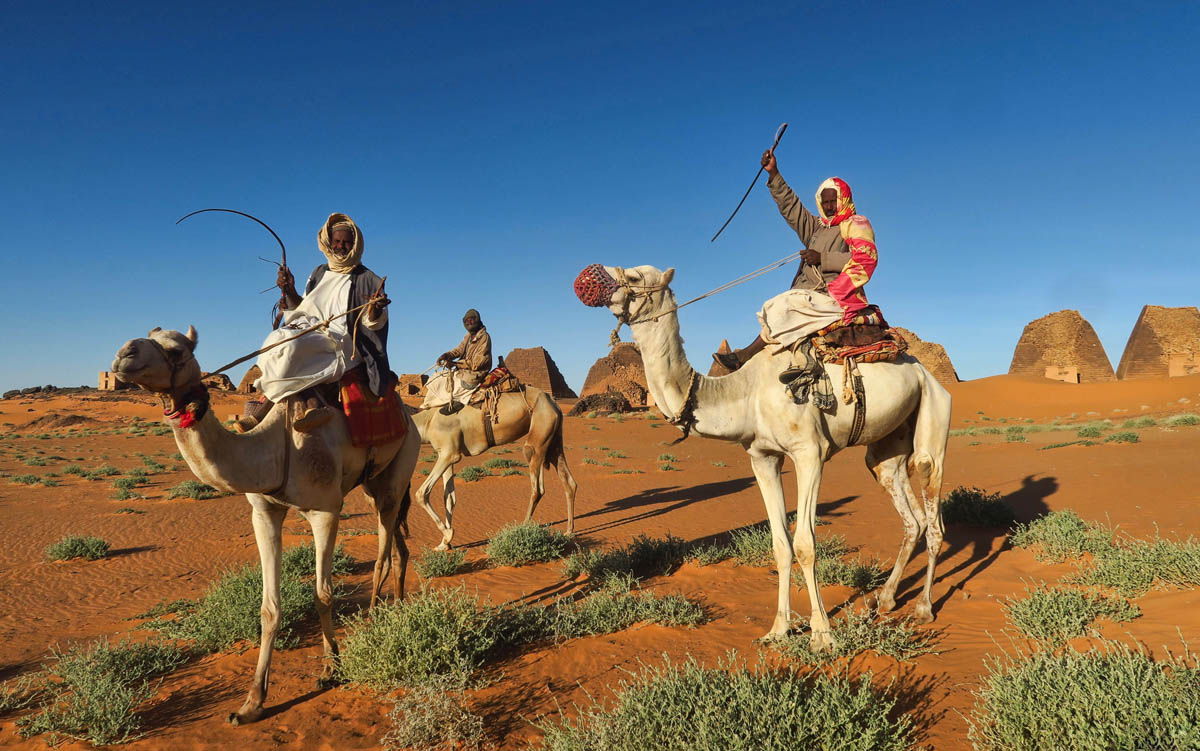
These camel herders asked me for money after I took this photo, which got them sorely reprimanded by our local guide. They don’t want it to become another “Giza.”


Our Tour Leader Louise takes a liking to the camel. The man on the left is Nazar, our local guide and “fixer” who has been traveling with us since Khartoum.

Typical roadside market in Shendi. We stopped here for a quick shop and to fill the truck tank with water. Several of us went into a tent where a local woman was selling coffee and tea (no photos allowed.) She served her coffee with ginger, and her tea with a sprinkle of cardamom. It was the best tasting hot tea I can recall since my grandmother’s.

In the afternoon, we moved on to two of the other three complexes that make up the “Island of Meroë,” Musawwarat es-Sufra. While this temple just looks like a jumble of rocks, look closely on both sides of the opening, and you will see legs and torso of two pharaoh-types guarding the entrance. And the round mounds of sandstone in the front were once a pair of seated lions.

This site, along with Naqa and the Meroë pyramids, make up the threesome in the area known as “The Island of Meroë” temple complex that was inducted into UNESCO World Heritage in 2011.
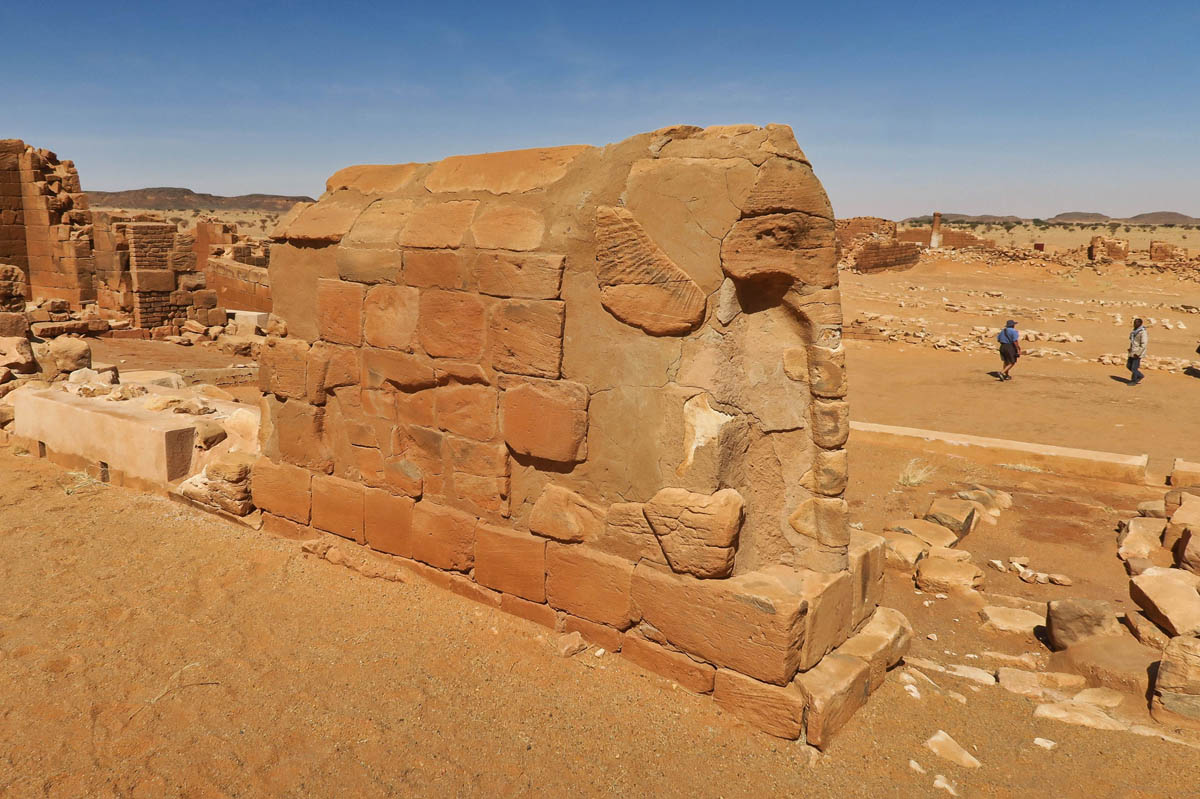
The remains of what was an elephant statue, believed to be dated to the early Meroitic period, the later 3rd and earlier 2nd centuries BC. You can still make out the ear, eye, and trunk.
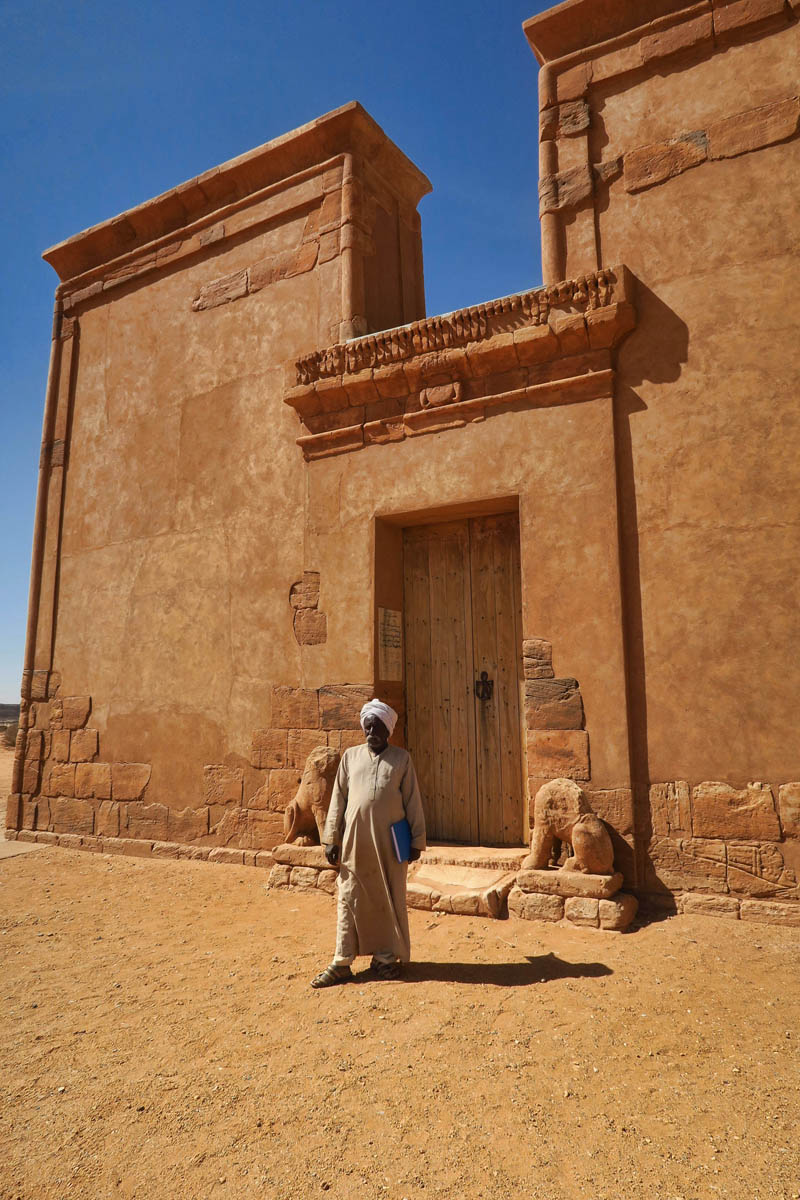
Just 600m away is the Lion Temple, dedicated to the lion-headed god Apedemak. Three of the outer walls and all four of the inner walls are covered in hieroglyphics.

When this temple was excavated in the 1960’s, it had collapsed from antiquity. They were able to reconstruct it due to the extensive carvings on both sides of the sandstone blocks. An ancient jigsaw puzzle.

Nice filtered light (filtered through the dust! haha!) inside the Lion Temple, supported by six columns.

Looks like dairy cows were a part of daily life of the Kushites.

Before we went on to visit the third temple in the trifecta that is the “Island of Meroe.” we stopped for lunch under some nearby trees. It didn’t take long until we were joined by this group of nomad children who had been hauling water from the nearby town well. Nazar gave them all individual packs of cookies. They were so very polite!

This is how water is carried for those who are fortunate enough to have the wagon.

The way the well system works is this small girl “drives” the two donkeys away from the well. The donkeys are pulling a rope attached to a large container. As they travel away from the well, the bucket is raised from the well, bringing the container full of water to the surface. The container is emptied, the rope is released, and the bucket falls back down as the donkeys return to do it all over again and again. Think about THAT next time you leave the water running while you are brushing your teeth!!

While we are having lunch, this “field trip” of young girl students pulls up. They sing and dance for us. These are obviously well heeled Sudanese, as a couple of the girls have ipads.

The last stop in touring the massive temple complex is Amun Temple of Naqa. Amun was a deity in Egyptian mythology who became the focus of the most complex system of theology in Ancient Egypt.

The entrance to the Temple of Amun is flanked by these curly-haired ram statues.

In reading up on this temple complex, one article referenced “the representations and more rarely inscriptions which adorn the sandstone walls, which form the largest corpus of graffiti known from the Nile valley.”

This “Roman Kiosk” looks a bit out of place with the other parts of the temple complex, but is supposedly built at the same time, and described as “one of the finest monuments of Meroitic architecture.” It was believed to serve as a “transitory” shrine in front of the Apedemak temple.
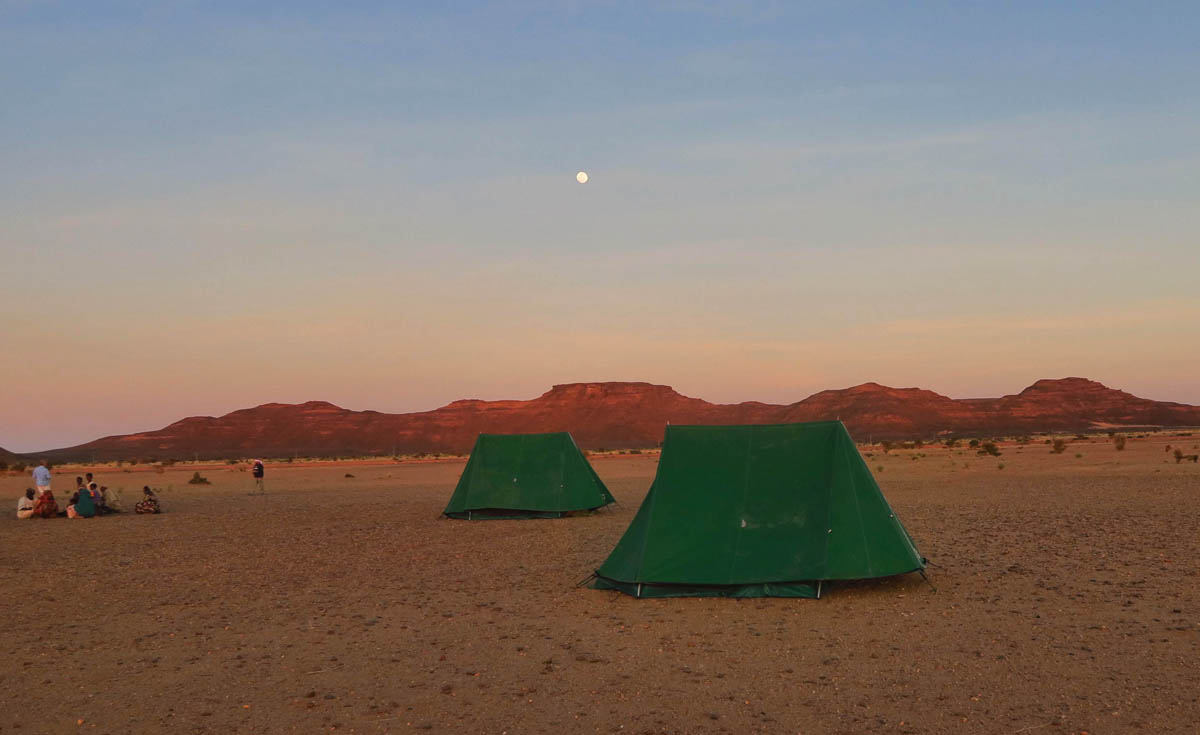
Our last desert camp of the Sudan Loop. Note full moon rising.

When we stopped to camp, we didn’t realize there was a nomadic tribe 10 minutes walk away. They all came out to watch, and patiently await any leftovers.
Next up: Crossing the border into Ethiopia.

Fascinating!
Brushing teeth…..the girl with two donkeys raising water from the well….it’s images like this that hit home. Sorry for another quote but this is what comes to mind: “It’s a dangerous business, Frodo, going out your door. You step onto the road, and if you don’t keep your feet, there’s no knowing where you might be swept off to.”
― J.R.R. Tolkien, The Lord of the Rings
You sweep all of us blog readers off our feet Suzanne. Safe travels.
I will think often about those kids getting water with the donkeys – halfway around the earth from me. And “apricot” is a good choice to describe the color of the sands and structures. I’d also be intimidated about cooking for 25 folks! in the desert! didn’t the local food have sandy grit all over it?
Wonderful. Such interesting pictures. Thanks. I like your comment below the pictures of collecting water, I am very conscious of the the blase attitude we have towards water.
Thank you for taking me along on your journey. Eye opening for me to see how blessed we are with our water being there with just a flip of the faucet. What an interesting part of our world you are showing us.
Again we are swept away. This is hands on history. A few places in Arizona one may wander among the “ancient” ruins of the earlier civilization, but here you can access all that you see and stereotypes are falling as a New England snow storm. We love all the beautiful people, the donkey and girl water pump, the respect that you show for the residents of the area. That one picture of ancient ‘graffiti’ also shows that ‘modern art’ ain’t so modern. The ‘Roman’ kiosk shows that the influence of the people living here had influence on later civilizations. Wow, Suzanne, wow.
allen and deede
How exciting!! This took me right back to Egypt. Good you didn’t take a camel ride. We did the camel ride at the Pyramids of Giza. The herder took John away on his camel and wanted money. Scary!! You saw so many spectacular sites. Something you will never forget. Thanks for sharing Sudan.
Those temples are incredible, thanks for sharing. That is truly a trip of a lifetime!
What a great adventure. Thanks for sharing
Were I a recording artist, “Pyramid at Sunrise” would be the title of my next work. Songs within it…”Russet” “Copper” “Apricot” to set the mood for haunting melodies. What a delight this post is with its history lessons and gorgeous photographs! Ingenious the travel agency is to require participants to “sing for their supper” by planning, acquiring and preparing food for the group. This one is treasure, Suzanne, one that the old rascal Giuseppe Ferlini can’t get his hands on to destroy! Thank you for allowing us a peek into the past of Sudan’s Meroe Pyramids…fascinating!